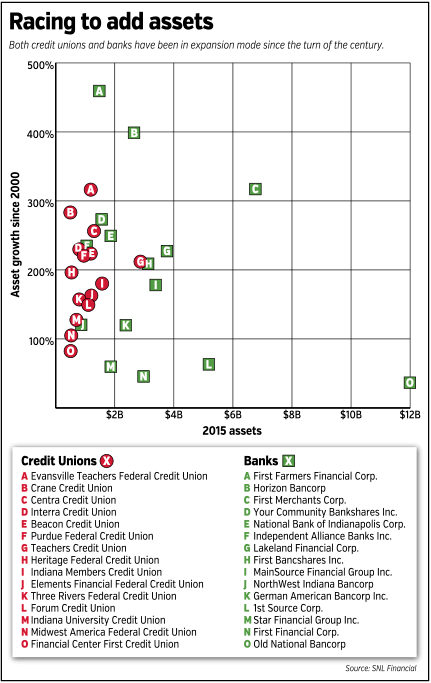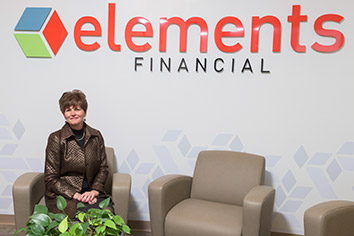Subscriber Benefit
As a subscriber you can listen to articles at work, in the car, or while you work out. Subscribe NowFor most of its 86-year history, Indianapolis-based Eli Lilly Federal Credit Union served only employees of the prominent drug maker. That changed about 2007 when it started serving other employee bases.
By the time “Elfcu” changed its name to Elements Financial in 2015, the credit union served workers from about 70 employers. It since has beefed up its growth ambitions even further, launching new marketing deals, expanding loans and scooping up a smaller credit union, among other efforts.
CEO Lisa Schlehuber said she intends to keep up the pace.
“If we’re standing still, we’re dying,” she said about Elements, the state’s fourth-largest credit union with $1.2 billion in assets.
Elements is not alone among big Indiana credit unions in ramping up growth, undaunted by the increasingly competitive banking landscape. Some credit unions have changed their charters to expand the pool of people who can become members. Others are poaching talent from banks with the aim of diversifying loan products.
At least one even bought a for-profit lender—a rare move for credit unions, which are not-for-profits owned by members.
“They’re trying to get larger, and they’re doing that through mergers and acquisitions,” Carmel-based bank consultant Mike Renninger said of credit unions. “And they’re hiring people with the appropriate expertise to make bigger loans.”
“So because of their relative size, they are now capable of competing against banks of similar sizes for loans. It used to be that credit unions, because they were only serving a small base of customers, weren’t very big.”
The state’s largest credit union, South Bend-based Teachers Credit Union, closed 2015 with $2.9 billion in assets—more assets than all but seven Indiana-based banks. If Elements were a bank, it would be the state’s 13th-biggest.
Credit union executives said they aren’t chasing growth as an end in itself, but rather as means to meet the expectations of 21st-century depositors and borrowers. Faced with continued competition from big banks and community banks—as well as emerging online lenders like Lending Club and OnDeck—credit unions are looking to boost earnings to invest in technology and talent.
Their growth ambitions haven’t gone unnoticed by commercial banks, which take umbrage with the fact credit unions have expanded their offerings while remaining exempt from federal income taxes. Rod Lasley, spokesman for the Indiana Bankers Association, said credit unions have historically served only one group of members and now they want to “welcome anyone.”
“The issue for us is, if they’re going be competitors—which they are in our markets—at least play by the same rules,” Lasley said. “The other thing they don’t have to face is nearly the level of compliance matters that bankers do.”
John McKenzie, president of the Indiana Credit Union League, said he believes it’s important that locally rooted credit unions get aggressive in promoting their advantages amid continued banking consolidation. He added that the top 100 banks out of the nearly 6,100 in the United States control 75 percent of assets.
Referring to banks’ gripes about federal income taxes, McKenzie said it’s an advantage credit unions enjoy because their mission is fundamentally different.
“The focus on returning earnings not needed for reserves to members through lower fees and better rates is fundamentally a different structure,” McKenzie said. He cited Credit Union National Association data showing credit union products yield $130 million in annual savings compared with bank products.
“A for-profit bank is in business to keep their stockholders happy by generating profits so that the stock value increases,” he said.
Membership blitz
The firepower for investing in technology and talent comes from earnings, which are primarily driven by loans. Because credit unions need to bolster deposits to fund more loans, they’ve been blitzing potential members on a variety of marketing fronts.
 Collier
CollierIndiana Members Credit Union, the state’s second-largest credit union with $1.6 billion in assets, has shifted marketing spending to television in recent years from areas like direct mail, CEO Ron Collier said. He said the Indianapolis-based credit union also is in its sixth year of a sponsorship deal with Fox Sports Indiana worth $100,000 to $150,000 a year.
“We just felt like we had a good story to tell,” Collier said, “and we had previously not done much on TV.”
Teachers Credit Union last year notched a three-year naming-rights deal for the Indiana Pacers’ practice court, but didn’t disclose financial terms. And in 2015, Elements signed a five-year, $80,000-a-year naming rights deal for the Blue Ribbon Pavilion at the Indiana State Fairgrounds, which hosts exhibits, trade shows and other events.
To juice growth, Financial Center First Credit Union in 2015 changed from a federal to a state charter—eliminating a restriction preventing it from serving customers outside the 10-county Indianapolis area. Under federal charters, credit unions can serve either a specific geographic area or specific companies no matter where employees live.
Financial Center had opted for the geographic area, but CEO Kevin Ryan told IBJ before the conversion that the restriction had forced it to turn down two mergers that fell outside its territory.
“There are many things we’re doing in this organization to increase income and offer our members better rates, lower fees and better products and services—but you’ve got to pay for them,” said Ryan, whose credit union has $512 million in assets. “And to do that, you have to grow.”
Ryan said the switch made sense for his credit union even though it now has to pay state sales taxes that federal credit unions do not.
Not all credit unions have followed the same playbook. Elements, for instance, has the federal employer-group charter and intends to keep the designation. Its list of about 80 employers includes CNO Financial Group, the United Way of Central Indiana and other organizations.
Even though it can’t serve just anyone in the geographic area, Elements has found plenty of opportunity to grow. Last fall, it merged with State Service Credit Union, which served about 1,200 of Indiana’s 28,000 state employees. This year, Elements won regulatory approval to add employees of Butler University and Indiana University Health.
Faster growth
 Collectively, Indiana’s credit unions have maintained a growth pace not far behind banks. According to SNL Financial data, the 15 largest credit unions in existence since 2000 have grown assets an average of 192 percent since 2000 versus 199 percent for the 15 largest banks.
Collectively, Indiana’s credit unions have maintained a growth pace not far behind banks. According to SNL Financial data, the 15 largest credit unions in existence since 2000 have grown assets an average of 192 percent since 2000 versus 199 percent for the 15 largest banks.
But credit unions have yet to demonstrate the rapid growth that some individual banks have. For example, Converse-based First Farmers Financial Corp, a $1.5 billion bank, saw its assets swell 460 percent since 2000. Meanwhile, the fastest-growing credit union in that span was Evansville Teachers Federal Credit Union, which increased assets 315 percent, reaching $1.2 billion.
Some credit unions want to pick up the pace.
In February 2015, Wabash-based Beacon Credit Union purchased Rushville-based Midwest Ag Finance for an undisclosed price, a deal intended to strengthen its position in making farm loans.
For their part, Elements officials said they are laying the foundation to start making commercial loans, as they look to serve some of the credit union’s 83,000 members connected to a small business.
“We have many members,” said Schlehuber, “and some of our members—partners, spouses, someone in their family—also own a small business. And we continually get asked, ‘You do such a great job on the personal side, why can’t I do my business activities with you as well?’”
Commercial banking isn’t entirely new for credit unions. Indiana Members Credit Union has been making commercial loans for at least a decade, with the push led by Michael Murphy, formerly of Peoples Bank.
Lately, Collier said, his Indiana Members has been focused on technology, unveiling smartphone applications, Apple Pay, and machines in branches that instantly issue debit and credit cards.
“The biggest change I’ve seen in the last five years is the ability to serve members 24/7 through their smartphones,” Collier said.
The road ahead
Despite credit unions’ growth, commercial banks headquartered out of state still hold sway over the Indiana banking landscape. In the Indianapolis area, the big three are New York-based JPMorgan Chase, Pittsburgh-based PNC Financial Services Group and Cincinnati-based Fifth Third Bancorp.
Andy Mattingly, the chief operating officer at Fishers-based Forum Credit Union, said credit unions’ and community banks’ real fight is against regional and national banks, which continue to dominate market share.
“Credit unions and community banks still have the same percentage of market share that they had 10 years ago,” said Mattingly, whose institution has $1.1 billion in assets.
“We feel like we’re like every other small financial institution, really fighting to compete with the big players who can offer all types of things that it’s harder for small organizations to offer,” he said.
Bank consultant Renninger said that as credit unions strive to grow faster, venturing into fields like commercial loans, they’ll likely have to offer ancillary services like treasury management that some businesses expect.
He said the transition is not without risk. Making larger loans also opens the door to potentially larger loan losses.
“You can lose on a car loan, if you underwrite it poorly, just like you can lose on a commercial loan—it’s just that a commercial loan is generally going to be bigger,” he said.
Renninger said that historically credit unions lacked lending sophistication, but that appears to be changing. So there’s nothing keeping them from upgrading their systems, upgrading their staffing and increasing their size.
“If they do all those things and have the advantage of no taxation and no shareholders to satisfy,” he said, “they should be able to provide very competitive services and very competitive prices.”•
Please enable JavaScript to view this content.

